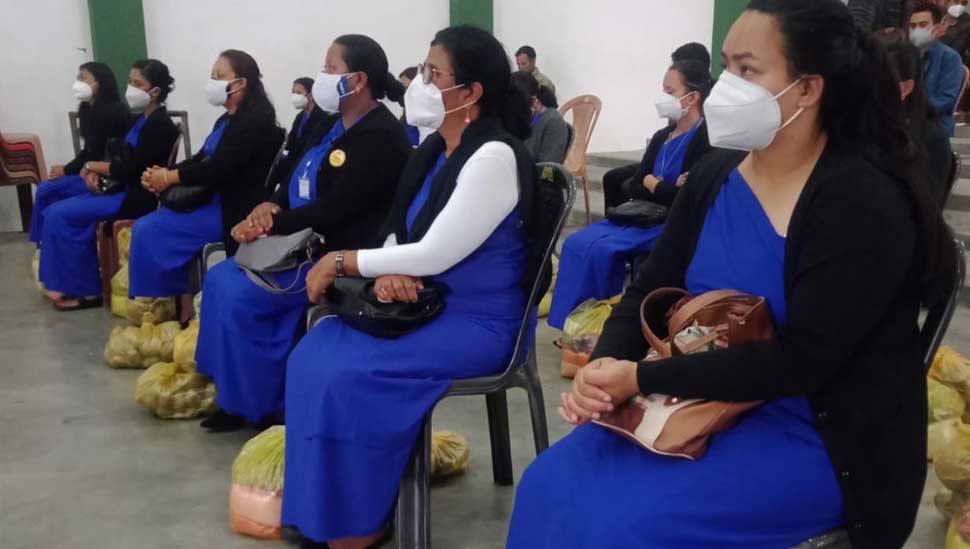A Campaign for the Rights of ASHA Volunteers

The covid19 pandemic should open our eyes to see the hard work and dedication of the ASHA volunteers. The ASHAs are the foot soldiers who acted as the first line of defence, not just during the combat against covid19, but in the larger battle for improving public health in the Country since its inception in 2005. This write up is neither to pay tribute nor to felicitate the ASHA volunteers, but it is an attempt to understand their contributions towards improving community health, the economy and to especially learn about their issues and plight. At the same time, it is a campaign for their rights.
The ASHAs are volunteers under the Government of India’s National Rural Health Mission. The object and reason of this mission is to recruit and appoint health volunteers in every village in the Country and these volunteers are the first point of contact in the chains of health services provided by the State. This group of health volunteers are vital for tackling health issues and planning. However, the usage of the term “volunteer” in the scheme is paving way for exploitation to a degree which is dehumanizing.
The amount of works and commitment made by the ASHA towards the mission, especially as witnessed during the pandemic 2020-21, has gone past those of regular health employees. The ASHAs are trained female health volunteers and while volunteering for the work their livelihoods should not be hampered, but the ground reality is that the ASHA is working fulltime from dawn to dusk to fulfil the tasks. The primary functions of the ASHA are, to mobilize the community for health camp and awareness programs, to teach and exhort the community on the importance of health interventions, to disseminate information on various health schemes and to guide people to make use of the services and facilities which are available to them. Her role is also to counsel and assist pregnant women; like in birth preparedness, help them to get access to institutional delivery, the importance of breast feeding and complementary feeding, immunization etc. The ASHA also gives awareness on health protocols and guide people to a healthy lifestyle. Moreover, they are also responsible to give care in limited health issues and make referrals.
As honorary volunteers the ASHAs do not get any salary or honorarium, but they are compensated for the works they perform in the form of monetary incentives. As per the Government of Meghalaya’s document, when the mission was launched in the State, the ASHAs were receiving Rs 150 to Rs 1000/ per month and the incentive earned by ASHA largely depends on the number of beneficiaries they could get in a month from the villages. There are various incentives under different schemes like, JSY, Family planning, Immunizations (UIP), Village Health Nutrition Day and other vertical programmes which they can accrue. Though these sources of incentives seem to be useful but they don’t add up to the sum, per ASHA. Despite the low incentives and the irregular payment of such incentives, it has been reported that the ASHA assisted institutional deliveries were very high under Dalu block in West Garo Hills in the past years.

Under the scheme each village has to constitute a Village Health and Sanitation Committee with ASHA as the secretary. The committee has to prepare and facilitate a health plan for the community in the village. But there are villages which do not have a Village committee and in the State like Meghalaya which do not have a robust Village Administration Law, the implementation of such a significant health mission might be suffering from serious lapses.
Till date there are about 6697 volunteers working in both urban and rural villages in the State. The ASHAs do not need our verbal praises and appreciations, rather the society should learn about their works in order to understand their plight. It has been said that the mission also provides a means of subsistence for women and to an extent the door- to-door visitations made by the ASHAs to enquire about the health of the people and to offer medical attention or remedies in certain cases have eased the burden of people and help them save their daily wage loss.
Are the incentives given to ASHAs enough to sustain and meet the basic requirements in life? It is heart wrenching to learn that for a door to door work they are paid a meagre amount of Rs 1650 (in other States) and between Rs 1850-2000 per month in Meghalaya. In the year 2011-12 the Government of Meghalaya had announced the ASHA Benefit Scheme (ABS) in order to augment the incentives, improve the working conditions and to tackle the issue of volunteers dropping out from the service. Under the ABS, the ASHA will be paid a matching amount she earned during a particular year. For example, if the ASHA earns Rs 1000/ from incentives throughout the year, she will be given the matching amount of Rs 1000/ by the State government and the incentives will be disbursed at the end of financial year in March. Perhaps, it is learnt that the ABS got discontinued in 2019 for the reason best known to the government.
It is important to lay bare before the public a sample of incentives which the ASHA earns. The ASHA can earn Rs 300/ in rural area and Rs 200/ in urban for ensuring antenatal care for woman. Also, she can earn Rs 100/ from attending quarterly meetings of the Village Health Committee, but where there is no Village committee, she loses a hundred rupees. The ASHA has to conduct health surveys in a village and subsequently compile the reports. On the basis of her report the Government makes health plan or even policy. In fact, they are now been tasked with malaria and tuberculosis control programmes etc. These programmes require certain knowledge which the ASHA has to undergo a special training. During the Covid19 pandemic the ASHAs are the ones who go from one household to another collecting data on covid19 patients while risking their lives and they also played a major role in vaccination drive in the village. The State Government had announced to accord Rs 1000/ as covid19 incentive per ASHA. Has the incentive reached the ASHAs in the State? It is perplexing to witness a few functions held in a couple of Shnongs or localities to felicitate or give cash rewards to the ASHAs. Where is the money coming from? It is unfair that only a few ASHAs in a few localities are being felicitated while the rest are being left out?
On two occasions the Meghalaya ASHA Workers Union had organized agitations and cessation of work to protest against the delay of payment of incentives, among other issues, in the year 2018 and 2021 respectively. During the agitations the ASHAs had expressed displeasure at the Government’s apathy towards their plight and demanded from the Government to disburse the incentives in a time bound manner. Today, in Meghalaya where do the ASHAs get their incentives from? Is it from the Central share only, which is Rs 2000/ per month? Where is the State Government’s matching amount of another Rs 2000/ a month which add up to a marginal sum of Rs 4000/? Thus, the ASHAs are the most underpaid workers/volunteers and they are being exploited to the hilt.
The work and services rendered by the ASHAs are humongous and significant to the society and health care interventions at the grass roots are perennial in nature. The local self-government, like the Dorbar Shnong can improve their role by way of legislation. However, at this juncture in the larger interest of the ASHAs in the State and for better implementation of the scheme it is necessary to extend support and joined forces with the ASHAs in their struggle for a just, fair and equal treatment. Therefore, I urge the general public to express empathy and demand from the Government the following; (i) to immediately amend Rule 9 of the guidelines and replace the word volunteer with worker. (ii) to consider ASHAs as workers in accordance with the Labour Laws (iii) to extend full rights and entitlements, like leaves, provident fund, medical and educational allowances etc (iv) to ensure that ASHAs get not less than Rs 18,000 as monthly earnings and they must be paid as per the Minimum Wage Act. (v) to consider ASHAs as skilled and highly skilled workers and pay them accordingly. (vi) to improve the working conditions, standardise the working hours and protect them from exploitations. In 2018, the ASHA Workers (Regularization of Service and Other Benefits) bill was introduced in the Parliament and although the Bill was a mere tokenism it is important to follow up and persist on the demands for uplifting the livelihoods of ASHAs.
It is our moral duty to stand in solidarity with the ASHAs and support them in all aspects. Lest the ASHAs will remain to be the most underpaid and exploited women workers in the State.
By | Kyrsoibor Pyrtuh

Leave a Reply